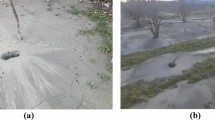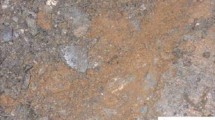Abstract
Liquefaction of saturated granular soils is marked by the total loss of shear strength of soil under dynamic cyclic or transient loading conditions due to excess pore water pressure that builds up to produce a soil regime that mechanically performs as a liquid. The cone penetration test (CPT) is widely recognized as a means of evaluating liquefaction susceptibility. This study presents a comparative supervised machine learning-based assessment for CPT-based liquefaction data. In particular, this study views soil liquefaction as a binary classification problem, whether the soil is liquefied or not, by utilizing three supervised machine learning classifiers: support vector machine, Decision Trees, and Quadratic Discrimination Analysis. To build the supervised machine learning models, three different soil characterization data sets were selected by performing CPTs at specific locations. The first input data (input data-1) is constructed as a function of the Mean Grain Size (D50), Measured CPT Tip Resistance (qc), Earthquake Magnitude (M), and Cyclic Shear Resistance (CSR). The second input data (input data-2) employed D50, Normalized CPT Tip Resistance (qc−1), M, CSR. Finally, the third input data (input data-3) consists of D50, qc−1, M, the Maximum Ground Acceleration (amax), Effective Vertical Overburden Stress, and Total Overburden Stress. The significance feature analysis shows the most important feature for assessing liquefaction susceptibility in the soil using input data for model 1 is measured CPT Tip Resistance, for input data model 2 it is normalized CPT Tip Resistance, and finally, for input data model 3, it is measured CPT Tip Resistance. Conclusively, this study proposed simple and quick approaches to evaluate soil liquefaction susceptibility without complicated calculations.











Similar content being viewed by others
Abbreviations
- qc :
-
Measured CPT tip resistance
- Fs :
-
Friction sleeve
- M :
-
Earthquake magnitude M
- D50 :
-
Mean grain size
- CSR :
-
Cyclic stress ratio
- qc-1 :
-
Normalized CPT tip resistance
- σʹvo :
-
Effective vertical overburden stress
- σvo :
-
Total effective overburden stress
- amax :
-
Ground surface
- AI :
-
Artificial intelligence
- SVM :
-
Support vector machine
- QDA :
-
Quadratic discriminant analysis
References
Al Bodour W, Hanandeh S, Hajij M, Murad Y (2022) Development of evaluation framework for the unconfined compressive strength of soils based on the fundamental soil parameters using gene expression programming and deep learning methods. J Mater Civ Eng. https://doi.org/10.1061/(asce)mt.1943-5533.0004087
Anderson D (2019) Understanding soil liquefaction of the 2016 kumamoto earthquake. Theses and Dissertations. Brigham Young University. 7135. https://scholarsarchive.byu.edu/etd/7135
Andrus R, Stokoe K, Chung R, Juang H (2003) Guidelines for evaluating liquefaction resistance using shear wave velocity measurement and simplified procedures
Baez JI, Martin GR, Youd TL (2000) Comparison of SPT-CPT liquefaction evaluations and CPT interpretations. In: Proceedings of innovations and applications in Geotechnical Site Characterization (GSP 97), Geo-Denver 2000, Denver, Colorado, pp 17–32
Beyzaei CZ, Bray JD, Cubrinovski M et al (2019) Characterization of silty soil thin-layering and groundwater conditions for liquefaction assessment. Can Geotech J. https://doi.org/10.1139/cgj-2018-0287
Bi C, Fu B, Chen J et al (2018) Machine learning based fast multi-layer liquefaction disaster assessment. World Wide Web. https://doi.org/10.1007/s11280-018-0632-8
CubrinovskiI M, Rhodes A, Dela Torre C et al (2018) Liquefaction Hazards from “Inherited Vulnerabilities.” Ce/papers 2:39–54. https://doi.org/10.1002/cepa.661
Fang J-T, Chang Y-R, Chang P-C (2018) Deep learning of chroma representation for cover song identification in compression domain. Multidimens Syst Signal Process 29:887–902. https://doi.org/10.1007/s11045-017-0476-x
Ghojogh B, Crowley M (2019) Linear and quadratic discriminant analysis: tutorial. arXiv Prepr arXiv190602590
Goh ATC (1996) Neural-network modeling of CPT seismic liquefaction data. J Geotech Eng 122:70–73. https://doi.org/10.1061/(ASCE)0733-9410(1996)122:1(70)
Goh ATC, Goh SH (2007) Support vector machines: Their use in geotechnical engineering as illustrated using seismic liquefaction data. Comput Geotech 34:410–421. https://doi.org/10.1016/J.COMPGEO.2007.06.001
Hanandeh S (2007) Estimation of rock mass deformation modulus by artificial neural network. Jordan University of Science and Technology
Hanandeh S (2022a) Evaluation Circular Failure of Soil Slopes Using Classification and Predictive Gene Expression Programming Schemes 8:1–11. https://doi.org/10.3389/fbuil.2022.858020
Hanandeh SM (2022b) Introducing mathematical modeling to Estimate Pavement Quality Index of Flexible Pavements based on Genetic Algorithm and Artificial Neural Networks. Case Stud Constr Mater. https://doi.org/10.1016/j.cscm.2022.e00991
Hanandeh S, Alabdullah SF, Aldahwi S, et al (2020a) Development of a constitutive model for evaluation of bearing capacity from CPT and theoretical analysis using ann techniques. Int J Geomate
Hanandeh S, Ardah A, Abu-Farsakh M (2020b) Using artificial neural network and genetics algorithm to estimate the resilient modulus for stabilized subgrade and propose new empirical formula. Transp Geotech. https://doi.org/10.1016/j.trgeo.2020.100358
Huang S, Cai N, Pacheco PP et al (2018) Applications of support vector machine (SVM) learning in cancer genomics. Cancer Genomics Proteomics 15:41–51
Idriss IM, Boulanger RW (2006) Semi-empirical procedures for evaluating liquefaction potential during earthquakes. Soil Dyn Earthq Eng. https://doi.org/10.1016/j.soildyn.2004.11.023
Idriss IM, Boulanger RW (2008) Soil liquefaction during earthquakes. Earthquake Engineering Research Institute
Javdanian H (2019) Evaluation of soil liquefaction potential using energy approach: experimental and statistical investigation. Bull Eng Geol Environ. https://doi.org/10.1007/s10064-017-1201-6
Juang CH, Yuan H, Lee D-H, Lin P-S (2003) Simplified cone penetration test-based method for evaluating liquefaction resistance of soils. J Geotech Geoenvironmental Eng 129:66–80. https://doi.org/10.1061/(ASCE)1090-0241(2003)129:1(66)
Mohanty S, Patra NR (2018) Ground motions and site response. In: Geotechnical earthquake engineering and soil dynamics V. American Society of Civil Engineers, Reston, pp 504–513
Mughieda OS, Bani-Hani K, Abu Safieh BF (2009) Liquefaction assessment by artificial neural networks based on CPT. Int J Geotech Eng. https://doi.org/10.3328/IJGE.2009.03.02.289-302
Njock PGA, Shen S-L, Zhou A, Lyu H-M (2020) Evaluation of soil liquefaction using AI technology incorporating a coupled ENN/t-SNE model. Soil Dyn Earthq Eng 130:105988
Oommen T, Baise LG, Vogel R (2010). Validation and Application of Empirical Liquefaction Models. https://doi.org/10.1061/ASCEGT.1943-5606.0000395
Owen G, Moretti M (2011) Identifying triggers for liquefaction-induced soft-sediment deformation in sands. Sediment Geol. https://doi.org/10.1016/j.sedgeo.2010.10.003
Pal M (2006) Support vector machines-based modelling of seismic liquefaction potential. Int J Numer Anal Methods Geomech. https://doi.org/10.1002/nag.509
Pathak SR, Purandare AS (2016) Liquefaction susceptibility criterion of fine grained soil. Int J Geotech Eng. https://doi.org/10.1080/19386362.2016.1160588
Rasouli H, Fatahi B, Nimbalkar S (2019) Liquefaction and post-liquefaction assessment of lightly cemented sands. Can Geotech J cgj-2018-0833. https://doi.org/10.1139/cgj-2018-0833
Samui P (2007) Seismic liquefaction potential assessment by using Relevance Vector Machine. Earthq Eng Eng Vib. https://doi.org/10.1007/s11803-007-0766-7
Samui P, Sitharam TG (2011) Machine learning modelling for predicting soil liquefaction susceptibility. Hazards Earth Syst Sci 11:1–9. https://doi.org/10.5194/nhess-11-1-2011
Seed HB, Idriss IM (1971) A simplified procedure for evaluating soil liquefaction potential. J Soil Mech Found Div 97:1249
Seed HB, Mori K, Chan CK (1975) Influence of seismic history on the liquefaction characteristics of sands. University of California, Earthquake Engineering Research Center
Seed HB, Mori K, Chan C (1975) Influence of seismic history on the liquefaction characteristics of sands. Report EERC 75-25, University of California, Berkeley
Setiawan B, Jaksa M, Griffith M, Love D (2018) Seismic site classification based on constrained modeling of measured HVSR curve in regolith sites. Soil Dyn Earthq Eng. https://doi.org/10.1016/j.soildyn.2017.08.006
Sharma K, Deng L, Khadka D (2019) Reconnaissance of liquefaction case studies in 2015 Gorkha (Nepal) earthquake and assessment of liquefaction susceptibility. Int J Geotech Eng. https://doi.org/10.1080/19386362.2017.1350338
Sideras SS (2019) Evolutionary intensity measures for more accurate and informative evaluation of liquefaction triggering. University of Washington
Stark TD, Olson SM (1995) Liquefaction resistance using CPT and field case histories. J Geotech Eng 121:856–869. https://doi.org/10.1061/(ASCE)0733-9410(1995)121:12(856)
Stolte AC, Cox BR (2019) Feasibility of in-situ evaluation of soil void ratio in clean sands using high resolution measurements of Vp and Vs from DPCH testing. AIMS Geosci. https://doi.org/10.3934/geosci.2019.4.723
Yang Y, Morillo IG, Hospedales TM (2018) Deep neural decision trees. arXiv180606988
Youd TL (2000) Updating assessment procedures and developing a screening guide for liquefaction sponsors sponsors
Zhang C, Jiang G, Su L et al (2018) Effect of dry density on the liquefaction behaviour of Quaternary silt. J Mt Sci 15:1597–1614. https://doi.org/10.1007/s11629-018-4930-5
Zhao X, Cai G (2015) SPT-CPT correlation and its application for liquefaction evaluation in China. Mar Georesources Geotechnol. https://doi.org/10.1080/1064119X.2013.872740
Author information
Authors and Affiliations
Corresponding author
Additional information
Publisher's Note
Springer Nature remains neutral with regard to jurisdictional claims in published maps and institutional affiliations.
Appendix
Appendix
This section describes the machine learning methods used to predict a new liquefaction model. The liquefaction potential was evaluated using CPT databases. The next parts present a concise explanation of the basic knowledge of these methods. The validation and quantification were performed by using overall accuracy, precision.
1.1 Supervised machine learning classifiers
This section summarizes some of the supervised machine learning techniques used in this article. In particular, the following methods are reviewed: Decision Tree, Support Vector Machine (SVM), and QDA.
1.1.1 Decision tree
The decision tree is one of the most popular supervised machine learning classifiers. This classifier operates by dividing the feature space into axis-parallel rectangles and labeling each rectangle with one of the two classes (Yang et al. 2018).
1.1.2 Support vector machine (SVM)
Support Vector Machine is a supervised machine-learning method that has been used for classification and regression analysis. The linear vector machine algorithm takes as input data consists of training examples \(\left({\text{x}}_{1} .{\text{y}}_{1}\right)\)…\(\left({\text{x}}_{\text{N}} .{\text{y}}_{\text{N}}\right)\) where the points \({\left\{{\text{x}}_{\text{i}}\right\}}_{{{\rm i}=1}}^{\text{N}}\subseteq{\text{R}}^{\text{P}}\) and the labels \({\text{y}}_{\text{i}}\in\text{Y} = \left\{{\pm 1 }\right\}\) for every \({\text{i}}\) and return a \(\mathrm{p}-1\) hypersurface (Huang et al. 2018).
1.1.3 Quadratic discriminant analysis (QDA)
In QDA, the decision boundary is assumed to be a quadratic surface. In other words, a QDA classifier tries to find a quadratic surface that best separates the training set data. From this understanding, QDA can be considered as a generalization of linear classifiers (Ghojogh and Crowley 2019).
Rights and permissions
About this article
Cite this article
Hanandeh, S.M., Al-Bodour, W.A. & Hajij, M.M. A Comparative Study of Soil Liquefaction Assessment Using Machine Learning Models. Geotech Geol Eng 40, 4721–4734 (2022). https://doi.org/10.1007/s10706-022-02180-z
Received:
Accepted:
Published:
Issue Date:
DOI: https://doi.org/10.1007/s10706-022-02180-z




